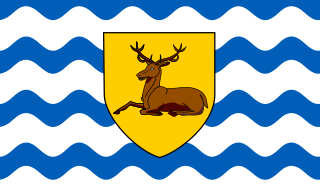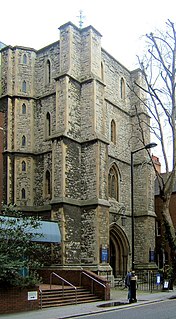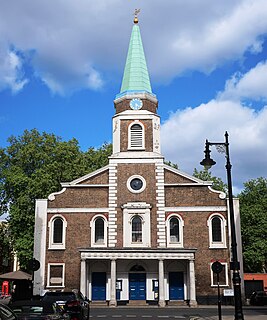St Albans is a city located in Hertfordshire, England. It was originally founded as Verlamion a settlement belonging to the Catuvellauni .It was subsequently transformed into the Roman settlement of Verulamium from where it grew into a municipium around AD 50. The city became known as St Albans around the 4th century AD with the martyrdom of St Alban who was buried close to the present day cathedral.

Hertfordshire is one of the home counties in southern England. It borders Bedfordshire and Cambridgeshire to the north, Essex to the east, Greater London to the south, and Buckinghamshire to the west. For government statistical purposes, it forms part of the East of England region.

St Albans is a cathedral city in Hertfordshire, England, east of Hemel Hempstead and west of Hatfield, 20 miles (32 km) north-west of London, 8 miles (13 km) south-west of Welwyn Garden City and 11 miles (18 km) south-east of Luton. St Albans was the first major town on the old Roman road of Watling Street for travellers heading north and became the city of Verulamium. It is within the London commuter belt and the Greater London Built-up Area.

The City and District of St Albans is a local authority district in Hertfordshire in the East of England region. The main urban settlements are St Albans and Harpenden. The council offices are in St Albans.

St Stephen's House is an Anglican theological college and one of five Permanent Private Halls of the University of Oxford, England.

The Colne is a river and a tributary of the River Thames in England. Just over half its course is in south Hertfordshire. Downstream, it forms the boundary between the South Bucks district of Buckinghamshire and the London Borough of Hillingdon. The confluence with the River Thames is on the Staines reach at Staines-upon-Thames.

Hertsmere is a constituency in Hertfordshire, England, represented in the House of Commons since 2015 by Oliver Dowden.

St Stephen's Church is a Church of England parish church in St Albans, Hertfordshire, England. It is located to the south of the town centre, at the top of St Stephen's Hill. It is a Grade II* listed building.

Sir John Ninian Comper was a Scottish architect; one of the last of the great Gothic Revival architects. His work almost entirely focussed on the design, restoration and embellishment of churches, and the design of ecclesiastical furnishings, stained glass and vestments. He is celebrated for his use of colour, iconography and emphasis on churches as a setting for liturgy. In his later works, he developed the subtle integration of Classical and Gothic styles, an approach he described as 'unity by inclusion'.

Chantry Island is currently a small (5,300sq.m.) deciduously wooded area with a narrow, and now dry, moat, giving the impression that it is an island. It is located in the grounds of the former All Saints Pastoral Centre in London Colney, Hertfordshire.

St Matthew's Church, Westminster, is an Anglican church in Westminster, London. Located in the heart of the capital, close to the Houses of Parliament, Westminster Abbey and Church House, St Matthew's has been closely associated with the recovery of the Catholic heritage of the Church of England from its early days. One of the foremost leaders of that movement, Frank Weston, Bishop of Zanzibar, served at St Matthew's from 1916–1918.

The Church of St John the Apostle and Evangelist is a Church of England parish church located in Sutton Road, close to the centre of the busy market town of Watford in Hertfordshire. It is within the Diocese of St Albans and has throughout its history been one of the leading Anglo-Catholic churches in the southeast of England. Today it is part of the Richborough Episcopal Area, and lies in the pastoral and sacramental care of the Provincial Episcopal Visitor.

All Saints' Church is a Church of England parish church in West Dulwich, South London. It is a red brick building designed in a Gothic Revival style by George Fellowes Prynne and built 1888–91. It is Grade I listed.

St Cyprian's Church is a parish church of the Church of England in the Marylebone district of London. The church was consecrated in 1903, but the parish was founded in 1866. It is dedicated to Cyprian, a third-century martyr and bishop of Carthage and is near the Clarence Gate Gardens entrance to Regent's Park, off Baker Street. The present church was designed by Ninian Comper and is a Grade II* listed building.

Verulam House is located in Verulam Road, St Albans on the northwestern side between Church Crescent and Britton Avenue opposite College Street. It has previously been referred to as Diocesan House and also known as the Bishop's Palace. It is of early nineteenth-century origin and is a Grade II Listed Building.

Grosvenor Chapel is an Anglican church in what is now the City of Westminster, in England, built in the 1730s. It inspired many churches in New England. It is situated on South Audley Street in Mayfair.
The Society of All Saints Sisters of the Poor is a religious order of sisters in the Anglican Communion. It was founded in 1851 and is active in England and the United States.

Napsbury Park is a residential development in Hertfordshire, England. It is located to the north of London, at Junction 22 of the M25 motorway and Junction 6 of the M1 motorway. It is protected by a Conservation Area.

Francis Walter Skeat was an English glass painter who created over 400 stained glass windows in churches and cathedrals, both in England and overseas. Skeat was a Fellow of the Royal Society of Arts, a Fellow of the British Society of Master Glass Painters, and a member of the Art Workers Guild.

Frogmore is a village 3 miles (4.8 km) north of Radlett in Hertfordshire, and 2 miles (3.2 km) south of St Albans. It is located in St Stephen civil parish, in St Albans District, in the county of Hertfordshire.


















